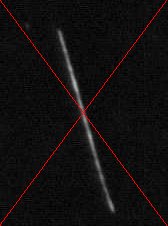WhOI Project Tricho
Some bacteria play important roles in regulating chemical cycles throughout our planet. Oceanic cyanobacteria, for instance, perform photosynthesis using energy from
the sun to fuel their own growth and produce oxygen as a byproduct.
One nitrogen fixing cyanobacteria that oceanographers think is really important is called Trichodesmium ("tricho" for short).
Although scientists have a general idea of where Trichodesmium grows, mapping out where it is and how abundant it is presents a challenge with something as small as a bacteria.
In order to know how much Trichodesmium is in the western North Atlantic, each of the images from the Woods Hole Oceanographic Institution Video Plankton Recorder (VPR)
must be classified. We need your help to identify the Trichodesmium! Your sorted images will be sent to scientists to aid in their research.
How to sort
I already know how to sort, let me play.
Although individual Trichodesmium cells are microscopic, they grow together in colonies that are large enough to be seen with the naked eye,
or in this case in magnified (about 10x) images from the VPR. Many cells grow together in a needle-like form called a trichome or filament,
and many filaments make up a colony. There are three common shapes colonies can take, called morphologies.
 The first is called "rafts". In raft colonies, all filaments are aligned approximately parallel to one another.
A distinguishing feature between rafts and other long, skinny flat objects is that individual filaments should be visible.
Often these filaments will be most visible at the ends of the colony, which may appear lighter.
The first is called "rafts". In raft colonies, all filaments are aligned approximately parallel to one another.
A distinguishing feature between rafts and other long, skinny flat objects is that individual filaments should be visible.
Often these filaments will be most visible at the ends of the colony, which may appear lighter.
 The second colony morphology is "puffs". Puffs are roughly circular in shape, and look a bit like pom-poms, with filaments radiating outward from the center,
which can sometimes appear dark. The best way to differentiate between puffs and other circular objects is to look for evidence of distinct filaments.
The second colony morphology is "puffs". Puffs are roughly circular in shape, and look a bit like pom-poms, with filaments radiating outward from the center,
which can sometimes appear dark. The best way to differentiate between puffs and other circular objects is to look for evidence of distinct filaments.
 The third morphology, "bowties", looks a bit like a cross between a puff and a raft. As its name suggest, it is shaped like a bowtie, with crossing
filaments that meet at a narrow center. It is different from a raft because the filaments are splayed out at the outer edge and different from a puff
because it is not a complete circle. Again, an important factor in identification is the presence of distinct filaments.
The third morphology, "bowties", looks a bit like a cross between a puff and a raft. As its name suggest, it is shaped like a bowtie, with crossing
filaments that meet at a narrow center. It is different from a raft because the filaments are splayed out at the outer edge and different from a puff
because it is not a complete circle. Again, an important factor in identification is the presence of distinct filaments.
Sometimes there are images that are borderline between a puff and a bowtie. In general, these should be classified as bowties.
Occasionally, there is an image that looks like it might be either a raft or a bowtie, and these should also be classified as bowties.
 The final category we are asking you to look for is "copepods". These animals are most easily identified by their antennae, which come out of their head much like an insect.
We are interested in them because certain species of copepod eat Trichodesmium.
The final category we are asking you to look for is "copepods". These animals are most easily identified by their antennae, which come out of their head much like an insect.
We are interested in them because certain species of copepod eat Trichodesmium.
All images that do not look like one of the three Trichodesmium morphologies or copepods should be classified as "none".
Individual Trichodesmium cells grow together in colonies of FILAMENTS (trichome). Depending on their shape they are called Puff, Raft, or Bowtie. If you don't see FILAMENTS then it's not one of these.
For Example:
These roughly circular shapes are NOT Puff because there are no FILAMENTS.


These long sticky shapes are NOT Raft because you cannot see FILAMENTS.


Read more
Play Project Tricho now.
Interested in seeing how real WHOI scientists took all these pictures you are helping to sort?
Click on the link to play now!
Play Project Tricho!